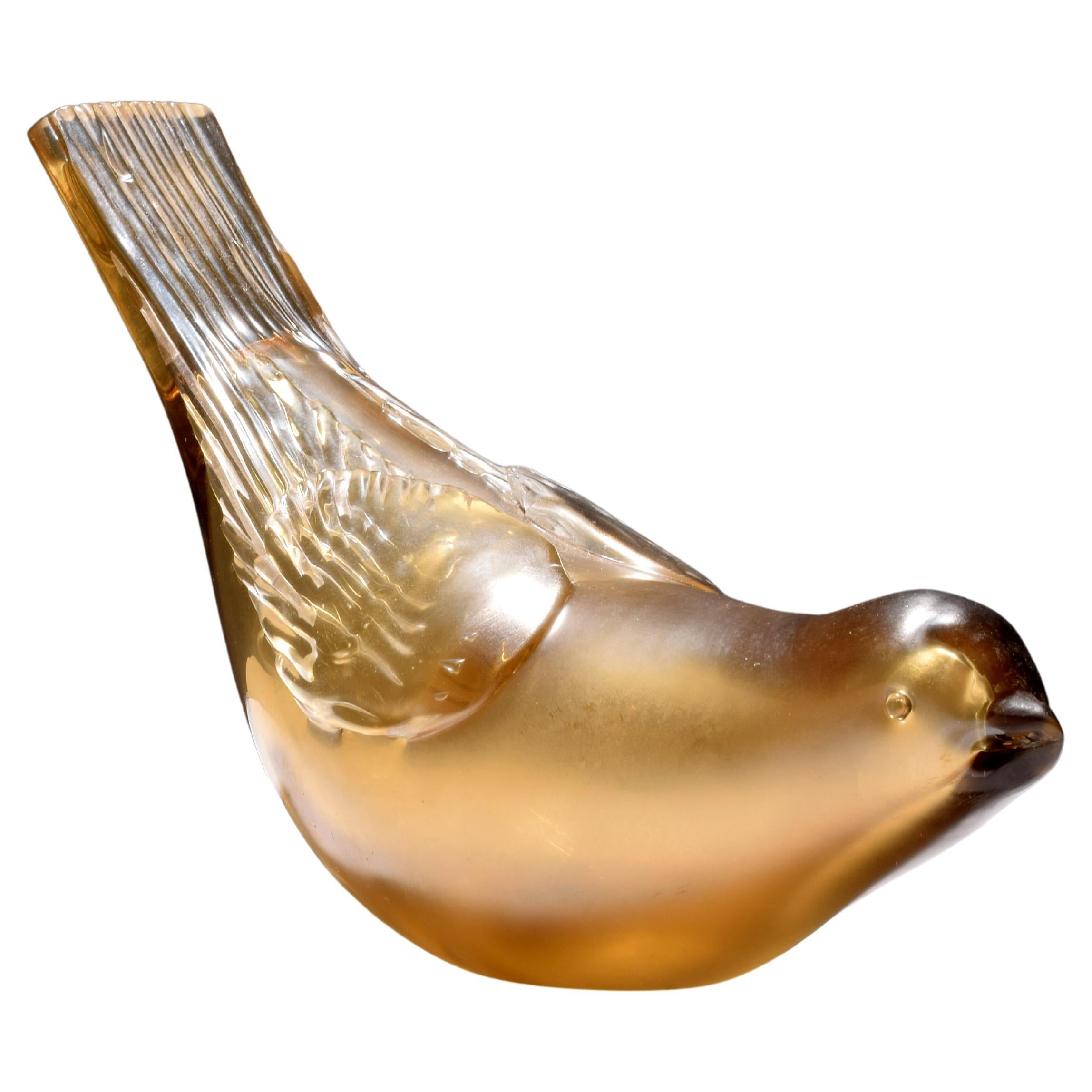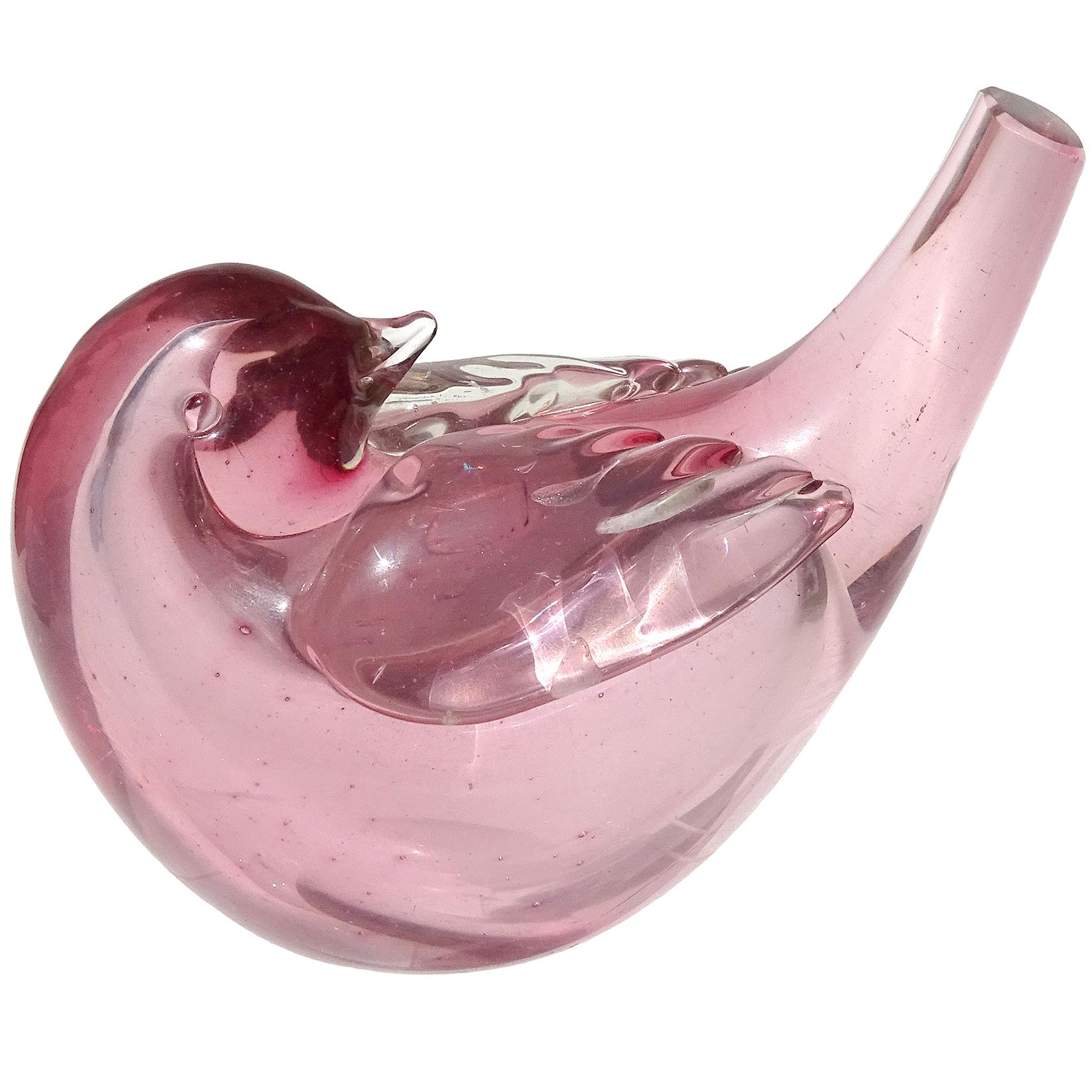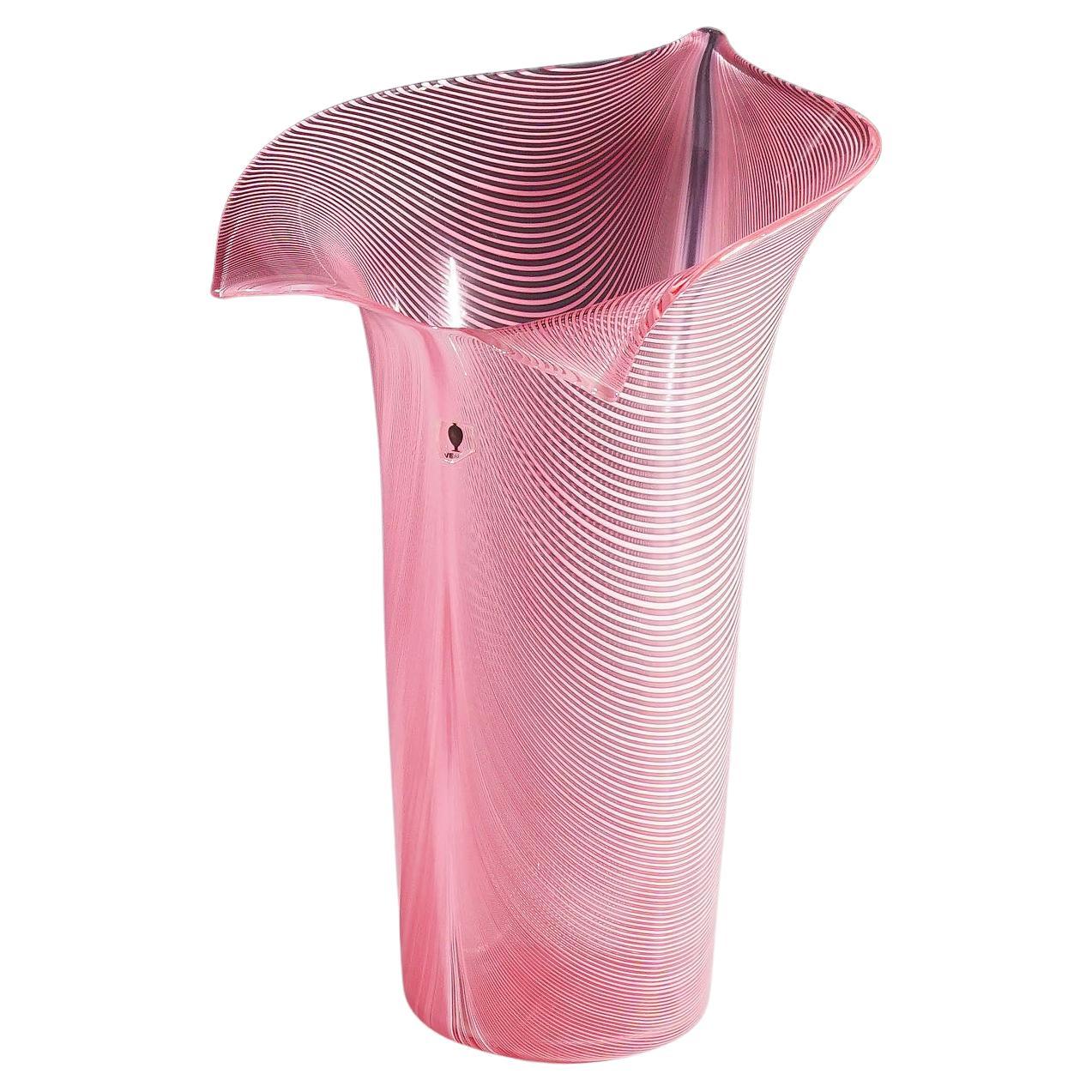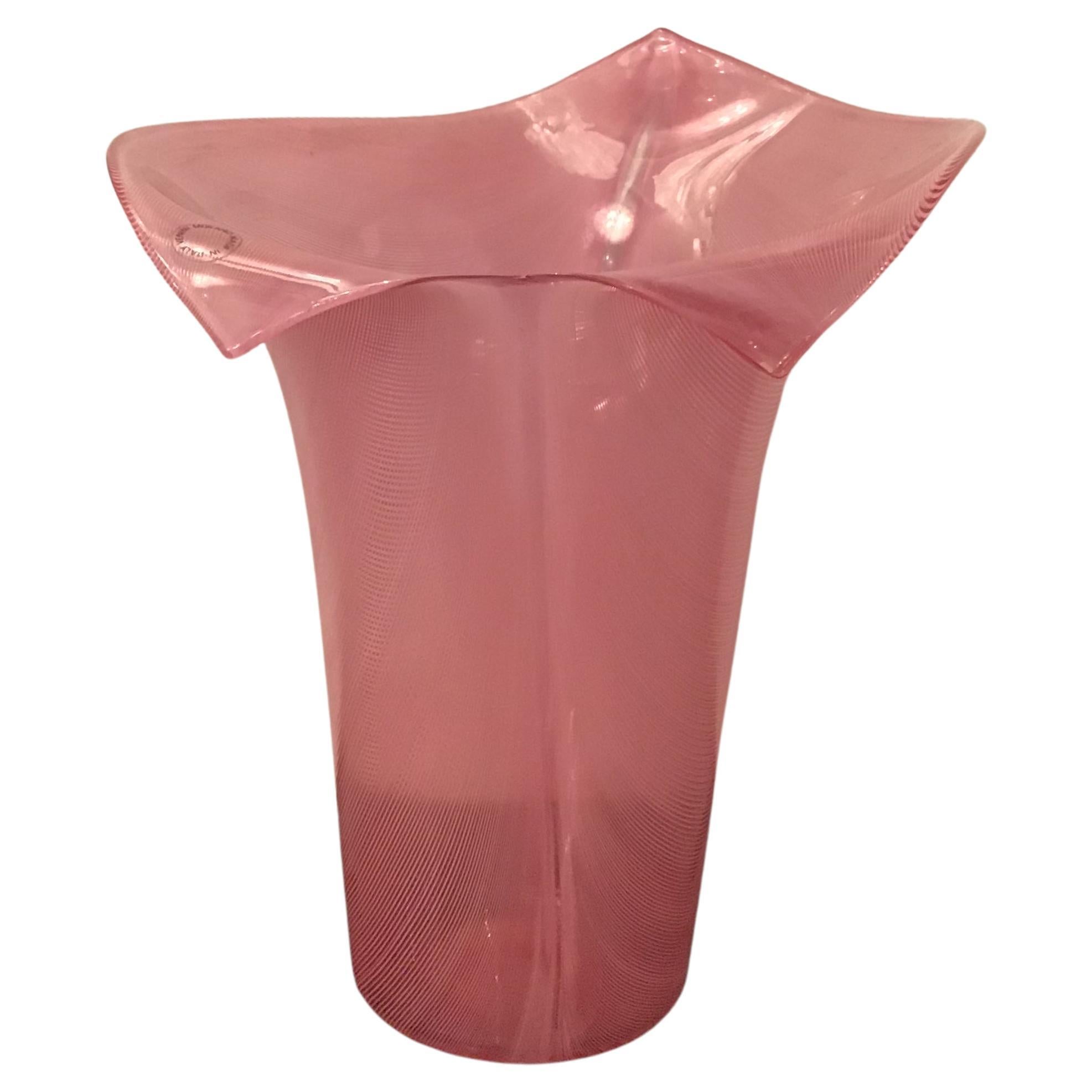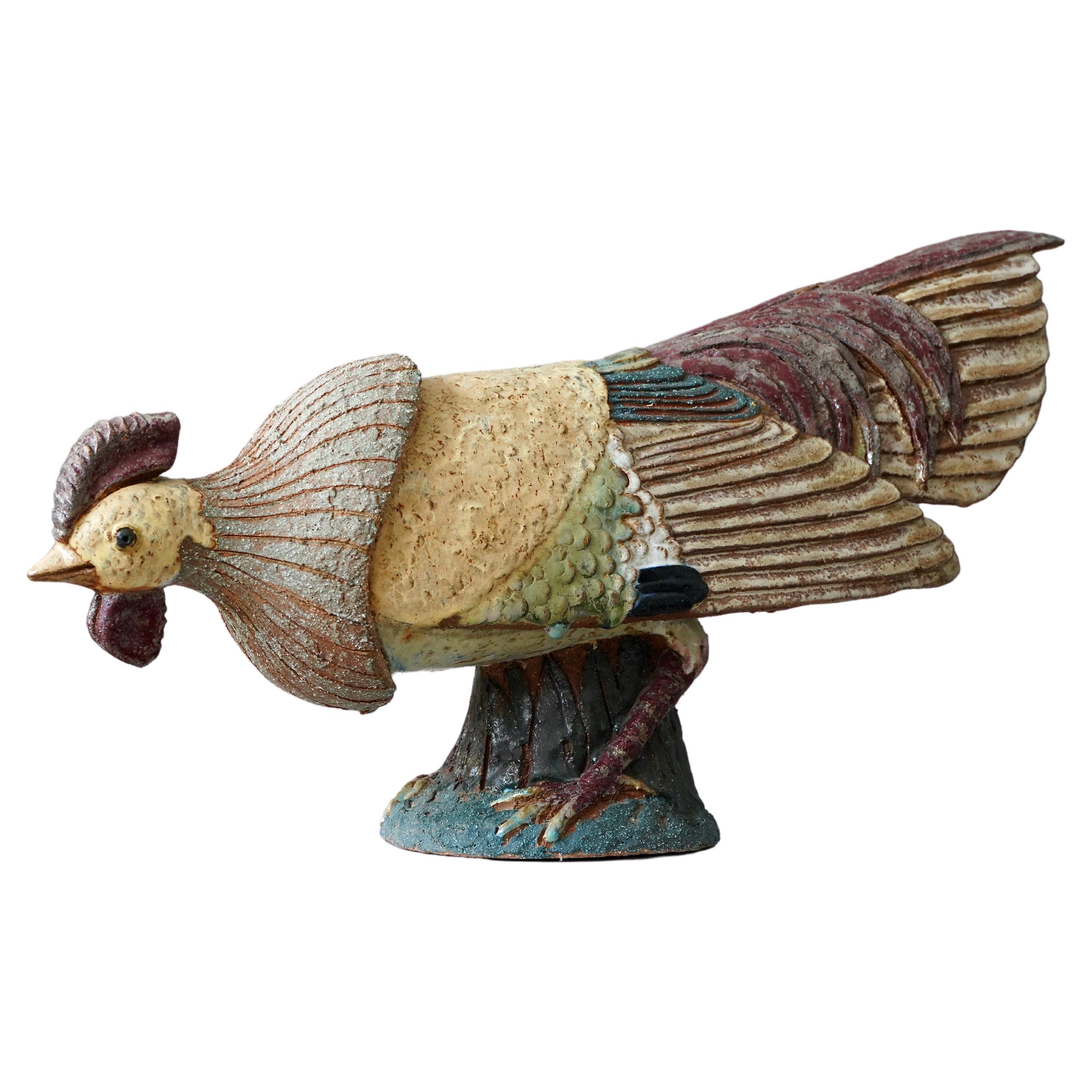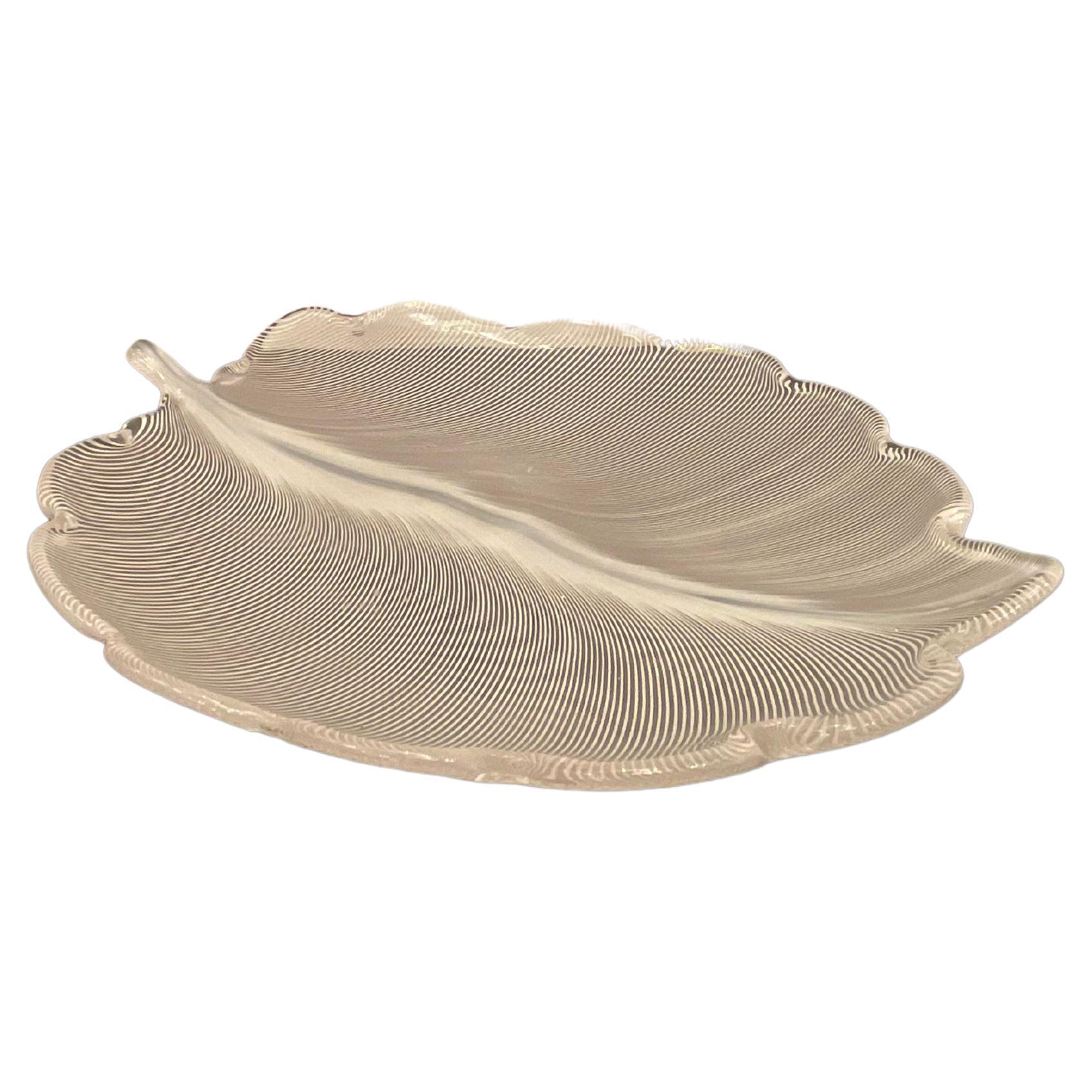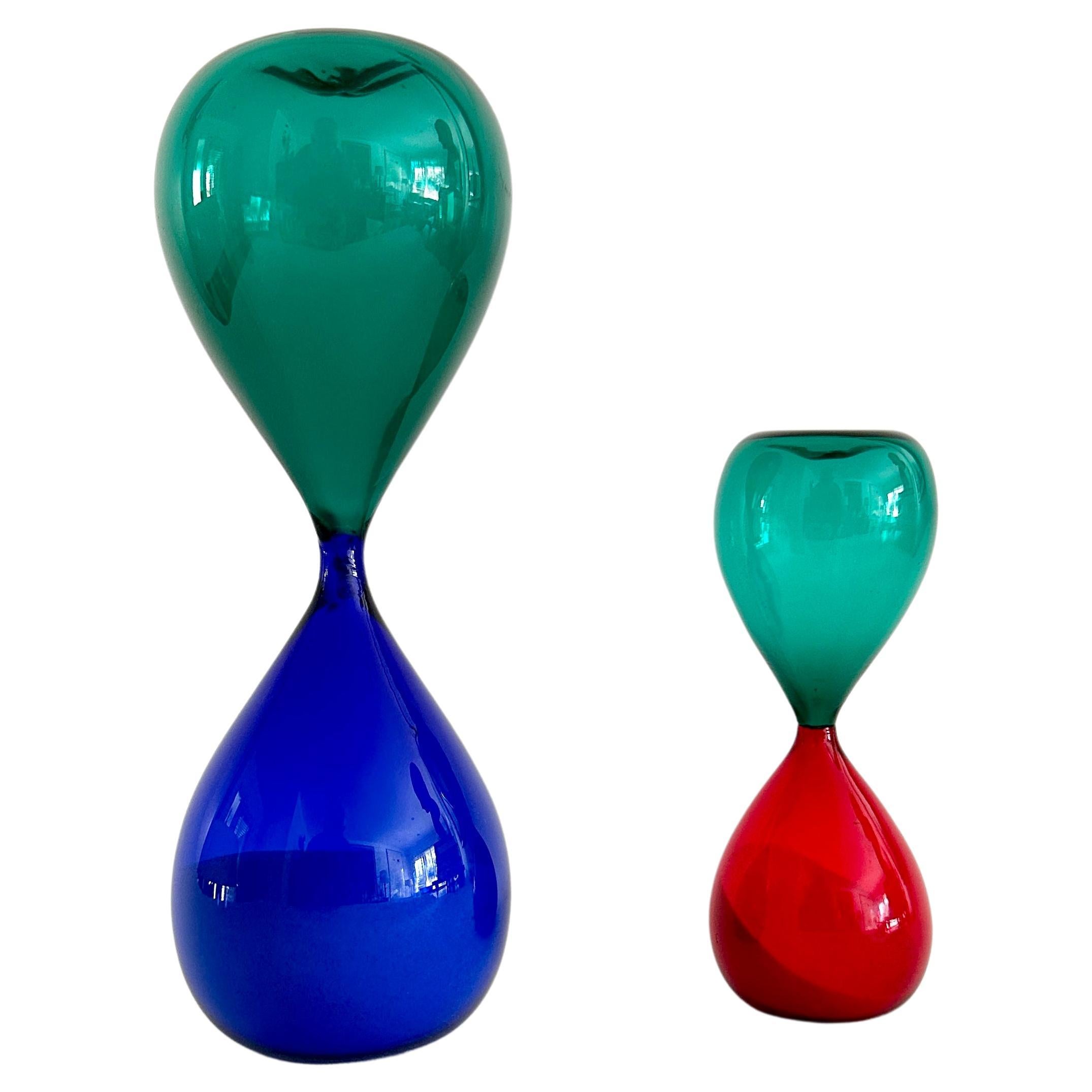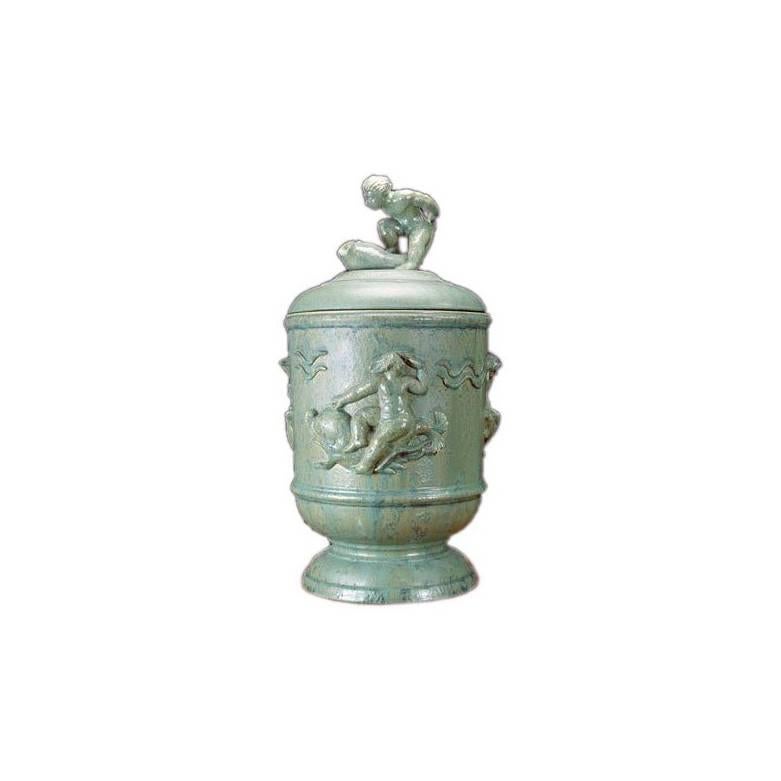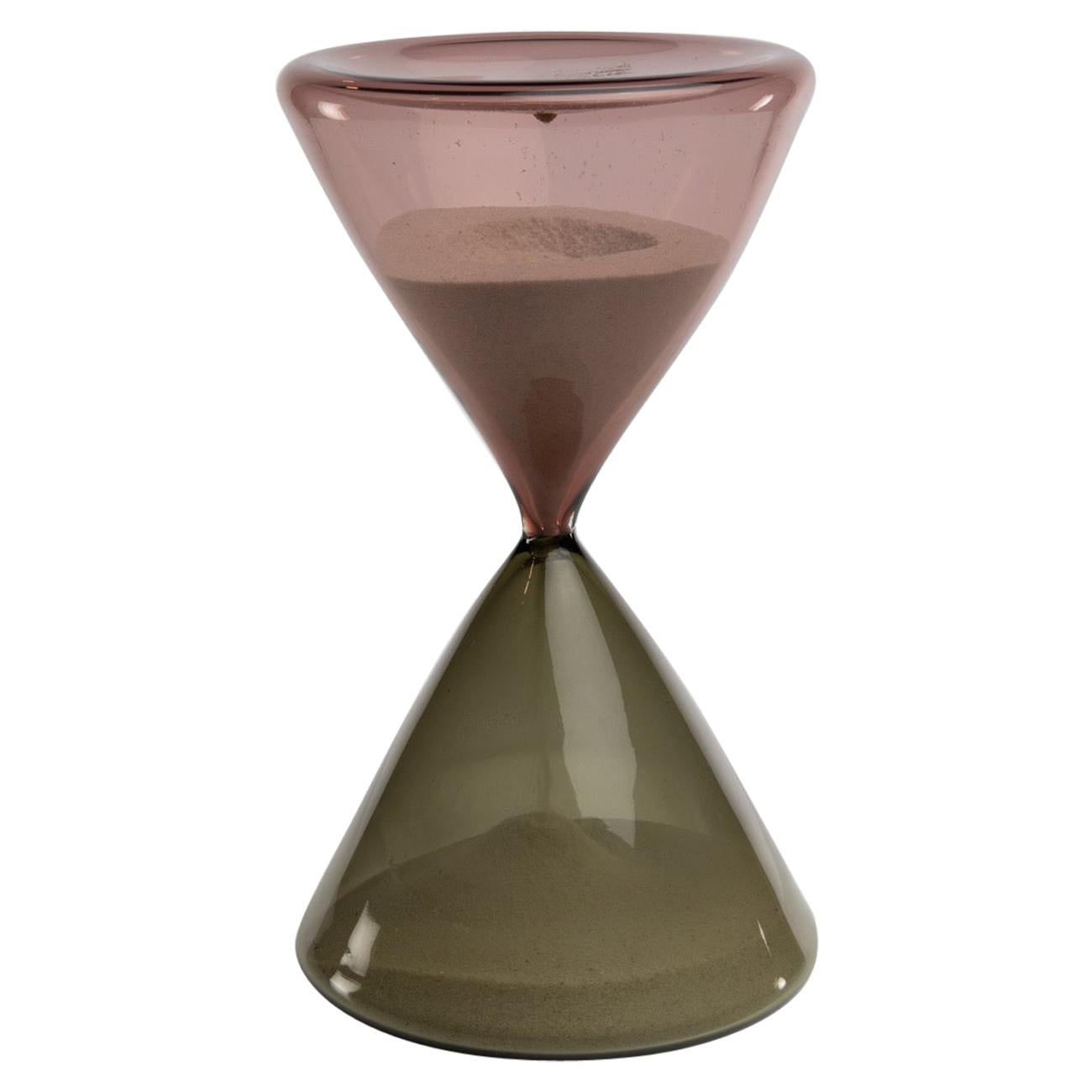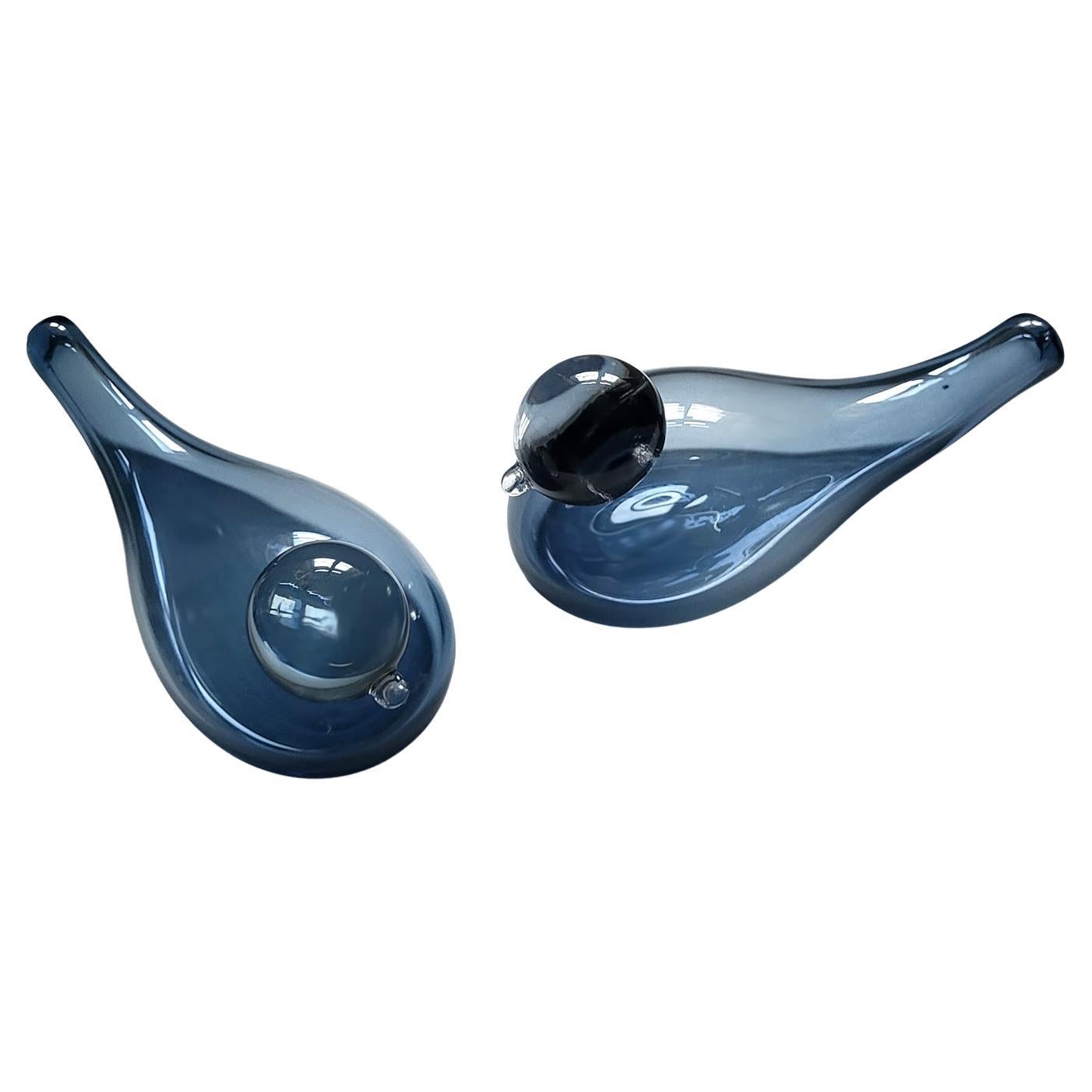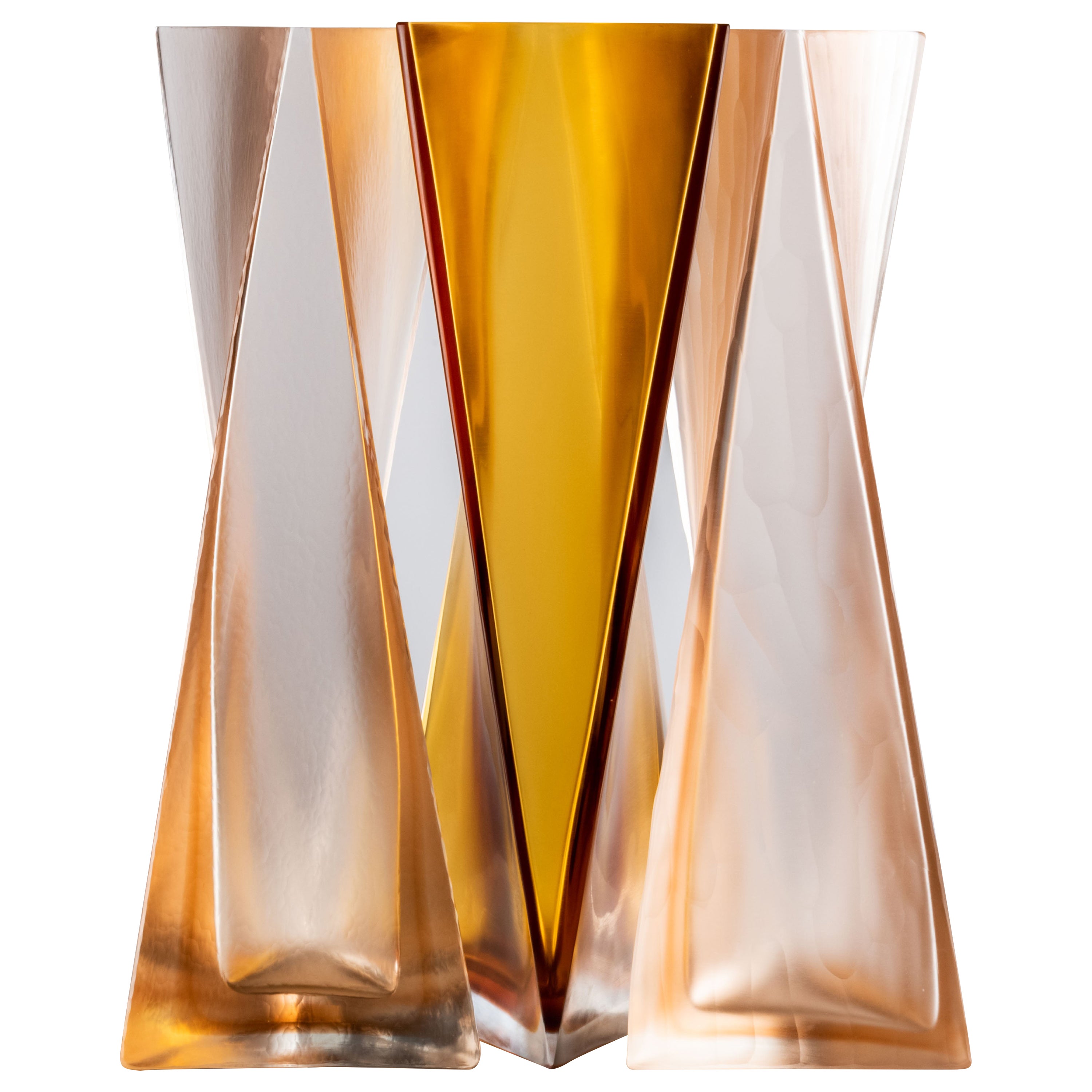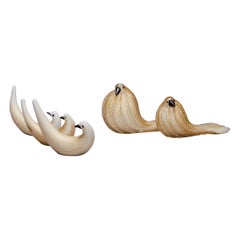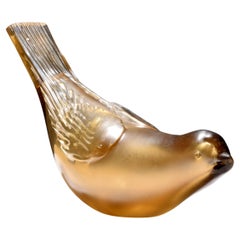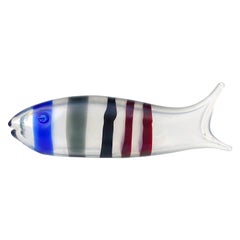
Pair of Birds Sculpture Hand Blown Glass by Tyra Lundgren for Paolo Venini 1940
View Similar Items
Want more images or videos?
Request additional images or videos from the seller
1 of 13
Pair of Birds Sculpture Hand Blown Glass by Tyra Lundgren for Paolo Venini 1940
About the Item
- Creator:Tyra Lundgren Carolina (Designer),Paolo Venini (Maker)
- Dimensions:Height: 5.12 in (13 cm)Width: 6.3 in (16 cm)Depth: 3.75 in (9.5 cm)
- Sold As:Set of 2
- Style:Mid-Century Modern (Of the Period)
- Materials and Techniques:
- Place of Origin:
- Period:
- Date of Manufacture:circa 1941
- Condition:Wear consistent with age and use. TYRA LUNDGREN (1897-1979) Two Bird Sculptures circa 1946 for Venini, model no. 2627, blown and applied glass with iridescent surface, each with acid stamp 'venini murano italia' height 4 3/4in (9.5cm); width 6 1/2in (16.5cm) US$ 2,000 - 3,000 € 1,600.
- Seller Location:London, GB
- Reference Number:1stDibs: LU1001522110622
About the Seller
4.9
Gold Seller
These expertly vetted sellers are highly rated and consistently exceed customer expectations.
Established in 2013
1stDibs seller since 2013
313 sales on 1stDibs
Typical response time: 2 hours
More From This SellerView All
- Venini Glass Pumpkin Sculptures by Napoleone Martinuzzi, 1920'sBy Napoleone Martinuzzi, VeniniLocated in London, GBTwo Pumpkin Sculptures by Napoleone Martinuzzi circa 1928 for V.S.M. Venini & Co., blown glass applied with pasta glass with gold foil applications ...Category
Vintage 1920s Italian Art Deco Figurative Sculptures
MaterialsArt Glass, Blown Glass, Murano Glass
- Sea Shell Sculpture with Crab Blown Glass by Alfredo BarbiniBy Alfredo BarbiniLocated in London, GBHand blown sculptural bowl in the form of a tropical conch shell with sea crab applied in clear glass merging into tones of green, brown and deep red with gold inclusions, by to Alfr...Category
Vintage 1960s Italian Mid-Century Modern Animal Sculptures
MaterialsArt Glass, Blown Glass, Murano Glass
- Group of Five Bird Sculptures in Gold Leaf Glass Barovier & TosoBy Barovier&TosoLocated in London, GBGroup of five bird sculptures in gold leaf glass by Barovier & Toso (1939) a famous Italian company that specialised in Venetian glass, the birds produced circa 1950. This was part o...Category
Vintage 1950s Italian Mid-Century Modern Animal Sculptures
MaterialsArt Glass, Blown Glass, Murano Glass
- Elongated Venini Murano Fish Sculpture 1950 in Reticello GlassLocated in London, GBLarge Murano Fish Sculpture (65 cm long) exquisitely blown glass and internally decorated with twisted strands of rust brown glass bleeding from burned orange into amber made using t...Category
Vintage 1950s Italian Mid-Century Modern Animal Sculptures
MaterialsArt Glass, Blown Glass, Murano Glass
- Expressive Bronze Abstract Sculpture of BirdLocated in London, GBAbstract bronze cast sculpture of bird about to fly, spreading its wings. The sculpture is Expressive in a brutalist manner. It stands on a cast bronze pedestal.Category
Vintage 1980s German Brutalist Animal Sculptures
MaterialsBronze
- Architectural Door Handles Alfredo Barbini 1940 Venetian Blown Glass Polar BearBy Alfredo BarbiniLocated in London, GBVenetian blown glass push and pull door handles from a hotel in Venice late 1940's, by Alfredo Barbini (1912-2007) for Vitreria Gino Cenedese, Italy. Polar bears climbing on geometric glaciers set in clear and opaque glass block set with brass mounts. One white and gold ice bear...Category
Vintage 1940s Italian Mid-Century Modern Architectural Elements
MaterialsBrass
You May Also Like
- Tyra Carolina Lundgren Bird Sculpture, MuranoBy Tyra Lundgren CarolinaLocated in Lake Worth Beach, FLArtist/Designer: Tyra Carolina Lundgren (Swedish, 1897-1979); Venini Additional Information: “Tyra Lundgren was one of the 20th century’s most multifaceted artists and modernists. S...Category
20th Century Italian Animal Sculptures
MaterialsGlass
- Venini 1930s Tyra Lundgren Murano Iridescent Italian Art Glass Fish SculptureBy Tyra Lundgren Carolina, VeniniLocated in Kissimmee, FLVery rare and large, antique Murano hand blown "A Fasce" striped Italian art glass fish with iridescent surface sculpture. Documented to Tyra Lundgren circa 1935-1936, fully signed "...Category
Mid-20th Century Italian Art Deco Glass
MaterialsGlass, Art Glass, Murano Glass, Sommerso, Blown Glass
- Venini Tyra Lundgren Murano Fully Signed Pink Italian Art Glass Bird FigurineBy Tyra Lundgren Carolina, VeniniLocated in Kissimmee, FLBeautiful, and rare antique Murano hand blown Sommerso pink Italian art glass bird figurine / sculpture. Documented to designer Tyra Lundgren for ...Category
Mid-20th Century Italian Art Deco Animal Sculptures
MaterialsGlass, Art Glass, Blown Glass, Murano Glass, Sommerso
$713 Sale Price24% Off - Tyra Lundgren Vase 'Calla' for VeniniBy Venini, Tyra Lundgren CarolinaLocated in Berghuelen, DETyra Lundgren Vase 'Calla' for Venini A calla vase in filigrana glass designed by Tyra Lundgren in 1948, manufactured by Venini, Venice 1981. Incised signa...Category
Late 20th Century Italian Mid-Century Modern Vases
MaterialsArt Glass, Murano Glass
- VENINI # Tyra Lundgren# Vase Filigrana Glass 1989 Murano ItalyBy Tyra Lundgren CarolinaLocated in Milano, ITVase VENINI.Category
Vintage 1980s Italian Other Vases
MaterialsMurano Glass
- Large and Unique Stoneware Rooster by Tyra Lundgren. Sweden, 1955.By Tyra Lundgren CarolinaLocated in Malmö, SEA stunning and unique stoneware rooster sculpture with amazing glaze. Made by Tyra Lundgren. Executed in her own studio in Sweden, 1955. Great condition, but with a couple of chips to the base (pictured). Signed by the artist in two places, and dated 1955-06-20. Provenance: bought from the estate of the artist in 1979. Tyra Lundgren (1897-1979) was one of the most multifaceted artists and modernists of the twentieth century. She was a painter, drawer, sculptor, ceramist, glass- and textile designer, as well as an author and an art critic. She was the first woman who designed glass for Paolo Venini at Murano in Venice and she also served as the artistic leader at Arabia in Helsinki at a time when men tended to hold those kinds of positions. Tyra Lundgren grew up in Djursholm, near Stockholm. Her parents were John Petter Lundgren, professor at Veterinärinstitutet (institute of veterinary sciences) in Stockholm, and Edith Lundgren née Åberg, who was a housewife and raised their six children. The bourgeois home also comprised a nanny and a female cook. The family were very socially active, travelled often, and enjoyed the outdoor lifestyle. Tyra Lundgren’s schooling began at Djursholm coeducational school, where her teachers included Natanael and Elsa Beskow and Alice Tegnér. Her school friends included Greta Knutson-Tzara, Stellan Mörner, and Ingrid Rydbeck-Zuhr. Tyra Lundgren knew from the time she was five years old that she wanted to be an artist. She first became aware of the profession through Axel Fahlcrantz, who rented a studio on the plot of land where she lived with her family. In 1913 she began to attend Högre konstindustriella skolan (HKS, now known as Konstfack, college of arts, crafts and design) where she studied decorative art as well as handicrafts in various forms until 1917. One of her fellow students and friends there was Estrid Ericson, who later founded Svenskt Tenn AB in 1924. Whilst attending HKS Tyra Lundgren also took painting lessons at the Althin school of painting. In 1917 she was accepted as a candidate at the Royal Swedish Academy of Fine Arts where, apart from breaks during which she undertook studies abroad, she remained until 1922. She spent a couple of months taking lessons from Anton Hanak in Vienna and from 1920–1923 she was a student of André Lhote in Paris. Tyra Lundgren was primarily active in four countries: Sweden, Finland, France, and Italy. She spent much of her professional life travelling and considered herself to be a European. Greece and Mexico also formed important centres in her artistic life, as did the USA. She had an extensive social network which included focal individuals within twentieth century-European and American artistic and cultural circles. Tyra Lundgren’s main artistic motifs were birds, fish, and people which she depicted through different techniques and materials. Her artistic expression involved a variety of different directions and styles. She was a pioneer of the 1920s Swedish Grace style, the name of which had been coined by the art critic Morton Shand at the Stockholm Exhibition of 1930. This was a Swedish Art Deco style, characterised by elegance and traditional art which contrasted with the current artistic ideals of functionalism. Tyra Lundgren made her debut at a group exhibition held at Kungliga Akademien för de fria konsterna in 1921. She went on to show her work at various exhibitions throughout the 1920s. After that period she only very rarely exhibited her paintings. Tyra Lundgren’s painted output can be divided into different periods or stylistic directions. The first of these, and the most extensive, was her post-Cubist period which began in 1920 on her arrival in Paris. Her paintings from this time and right up to the mid-1930s typically comprise portraits, self-portraits, live-model painting, still-lifes, interiors, and landscapes in the Cubist style. Many of the great number of self-portraits she painted were produced in the New Objective style, displaying broad variation in terms of clothes, poses and techniques. Two of these – Huvud med vit duk and Självporträtt both from 1921 – can be seen at Moderna Museet in Stockholm, although the majority of these works are at Gotlands Museum. Tyra Lundgren’s second artistic period comprises the years of 1927 to 1929 and is characterised by the New Objective style inspired by medieval techniques and materials (Giotto, Piero della Francesca). Her motifs were still-lifes and landscapes. At this point she was living in Rome and was close to the circle involved in the Valori plastici: rivista d’arte art journal. This period saw a breakthrough in her development as a painter. From the 1950s through the 1970s her work can almost be described as belonging to the Concrete style. Using light pastel colours her paintings sought light in a sometimes non-figurative expression, but often depicting abstract bird-shapes or other nature-inspired imagery. Her paintings from this period are outsized and display powerful colours, in yellows, reds, and blues. Tyra Lundgren maintained a constant production of drawings, both in terms of individual artworks and sketches for patterns and designs. She also produced the illustrations for her book Fagert i Fide. Årstiderna på en gammal gotlandsgård, published in 1961. During her early years she also produced advertising illustrations. She spent the final years of her life primarily working with lithographs which were printed at Galleri Prisma and depicted images of doves, swallows, magpies and crows. Tyra Lundgren is meanwhile best known for her work as a ceramist and in this sphere she was one of Sweden’s leading exponents. She worked in the porcelain industry as a designer and as an artisan and ceramic sculptor. Her first job was at St Eriks Lervarufabrik in Uppsala from 1922–1924, she then worked at Arabia from 1924–1937, and at Rörstrand and Lidköping Porslinsfabrik. She was the artistic leader at Arabia ahead of the 1930 Stockholm Exhibition and she exhibited her work at the World’s Fairs. During the 1934–1938 period she was connected to the Manufacture nationale de Sèvres porcelain factory in Paris. Tyra Lundgren was a pioneer when it came to giving ceramic art a public space in Sweden. She produced around 20 outsized reliefs in stoneware, so-called monumental reliefs. One of these is Märkeskvinnor, from 1947, for the former girls’ school at Bohusgatan in Stockholm. From the 1940s onwards Tyra Lundgren produced sculptural objects in Chamotte clay and stoneware, with various glazings. Her small birds are well-known and popular with many. When her ceramic efforts became too much for her during the 1970s she then produced models for sculptures in bronze. There are six of these in various places around the globe, including Solfågel in Almedalen, Visby. Tyra Lundgren began to work as a glassware designer at Moser in Karlsbad in 1922 where she designed new table services and modernised older ones. She also worked freelance for Riihimäki factory in Finland during the 1924–1929 period. From 1934 to 1938 she was employed by Kosta glass factory where she mainly designed thick-walled bowls and vases, engraved with classical motifs. She was introduced to the glassmaker Paolo Venini at Murano during the Triennale di Milano of 1936 and they began a collaboration that lasted into the 1950s. As part of this collaboration Tyra Lundgren became the first woman to design glassware and, in conjunction with the glassblower Arturo Biasutto, she developed new techniques of glass production. Her motifs at this point were birds, fish, snail-shaped designs and leaf-patterned bowls using traditional techniques as well as in new designs. It was during this time that she created the so-called tissue-shaped bowls and it remains unclear as to who specifically came up with the design but Tyra Lundgren claimed it was of her making. Tyra Lundgren was active as textile designer for Licium (now HV Licium), the sacred textiles...Category
Mid-20th Century Swedish Scandinavian Modern Animal Sculptures
MaterialsCeramic, Stoneware
Recently Viewed
View AllMore Ways To Browse
Pair Of Murano Glass Birds
Barovier Bird
Venini Glass Birds
Venini Bird
Iridescent Glass Animal
Pagliesco Glasses
Tyra Lundgren Carolina
Metal Silver Bird
Hand Carved Fish
Vintage Feather Birds
Pair Decorative Horse
Large Brass Animal Sculpture
Modern Dog Sculpture
Antique Horse Figure
Semi Precious Carve
Dove Bird
Black Forest Bear
Animal Figure Glass
